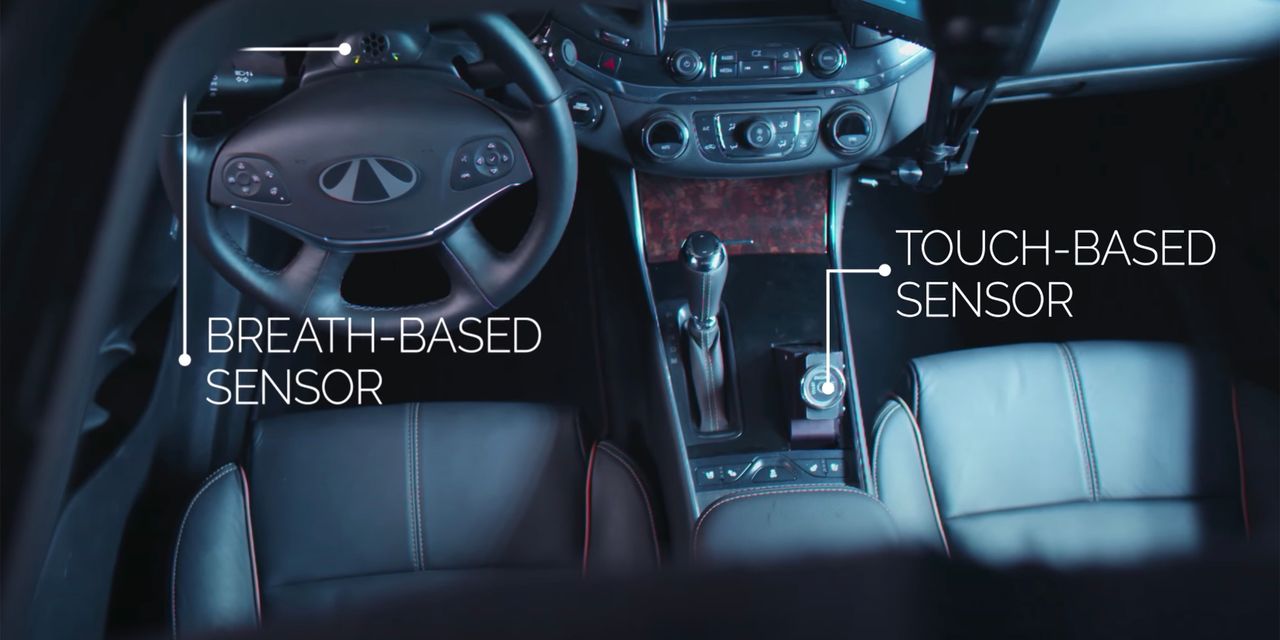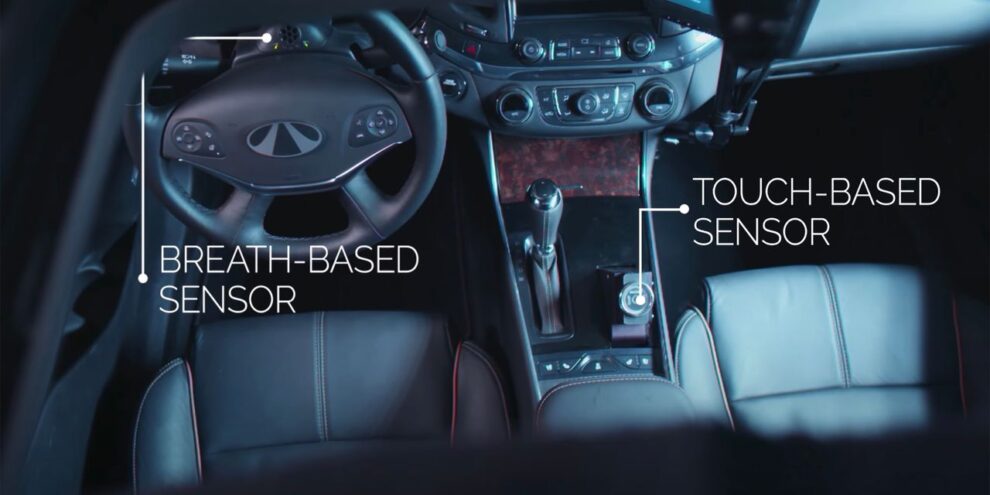
With more than 2,700 pages of text, the bipartisan infrastructure law is chock-full of provisions — including one that mandates new technology to prevent drunk driving.
Such technology, says one auto-industry executive working to develop it, involves breath-based or touch-based sensors that function without drivers having to do anything differently as they start their engines.
“It’s novel technology that will be able to measure your either breath or blood alcohol concentration — very rapidly with high precision and accuracy — without you doing anything that you aren’t doing now, when you’re interacting with your car,” said Robert Strassburger, president and CEO of the Automotive Coalition for Traffic Safety, a group based in the Washington, D.C., area and made up of the major automakers, including Ford F, +1.85%, GM GM, -0.68%, Chrysler parent Stellantis STLA, +0.10%, Toyota TM, -0.01%, Volkswagen VOW3, +0.20% and Honda HMC, +0.45%.
“If you are over the legal limit, or some other limit that you might set, it would not allow the car to start, or the car would start but not move, or give you a warning, depending on how it’s integrated into a vehicle. All three of those are options,” Strassburger added.
“Ultimately, it would give you, the driver, or you, the parent, the added peace of mind that you yourself are good to go, or your child maybe driving the car that night is good to go.”
The maximum level for blood alcohol content (BAC) in nearly all U.S. states is 0.08% for people 21 or older.
The bipartisan infrastructure law, known as the Infrastructure Investment and Jobs Act, says the U.S. Department of Transportation, acting through the National Highway Traffic Safety Administration, must issue a new standard for “advanced drunk and impaired driving prevention technology” in new vehicles no later than three years after the bill’s enactment, meaning potentially in 2024. The act is silent on other details, such as whether the anti-drunk driving technology definitely would immobilize a car, or only give a warning.
President Joe Biden signed the infrastructure package into law on Monday. That’s after the Democratic-run Senate passed it on Aug. 10 in a 69-30 vote, and the House of Representatives approved the measure on Nov. 5 in a 228-206 vote.
The NHTSA and the Automotive Coalition for Traffic Safety, Strassburger’s group, have been working together to develop the new technology through what’s known as the Driver Alcohol Detection System for Safety research program, or DADSS. The program is tackling a big problem, as an estimated 10,000-plus people are killed each year in the U.S. because of drunk driving.
“That’s a tragedy in and of itself, and for every person that is lost, there’s untold family members, colleagues, etc. that are impacted as well,” Strassburger said.
Privacy concerns
Automakers are aware of the privacy worries raised by the new technology to prevent drunk driving, Strassburger said.
“We think we’ve addressed that with the ‘Consumer Privacy Protection Principles,’” he said, referring to guidelines for personal data that carmakers have agreed to meet or exceed. “There are other concerns related to that. We’re committed to addressing those concerns.”
Strassburger said surveys have found about 75% of respondents think the DADSS program is a good idea.
“Surprisingly, those that identify as heavy drinkers actually wanted more. They want the help,” he told MarketWatch.
The Center for Democracy & Technology’s Samir Jain, meanwhile, argues there should be more protections for personal information than the industry principles. His organization advocates for privacy rights and for stronger controls on surveillance programs.
“Industry best practices alone — it’s usually not a reliable or foolproof way of really protecting user privacy, because they have their particular interests, and sometimes may not appreciate all the concerns,” said Jain, who is the organization’s director of policy and a former Obama administration official.
Jain also said there might not be significant privacy concerns around the technology as it rolls out in the years ahead if it were configured to simply not allow a car to be operated when a driver was found to be drunk, but it “didn’t collect any data about the fact that that had happened.”
The Electronic Frontier Foundation’s Lee Tien said nobody wants drunk drivers, but at the same time “you want to be really careful that any system of technology that is basically driving surveillance doesn’t go beyond what it needs to be.”
“Mission creep is a big issue,” said Tien, who is a senior staff attorney and Adams Chair for Internet Rights at the EFF, a digital rights group. “There’s so much incentive, between the public and the private sector, to say, ‘Well, we could force people to collect this information,’ and, ‘We would really like it if you did. We could use the information.’ Companies and the government sort of have aligned interests, and they’re kind of not aligned with consumers.”
Tien said the infrastructure package doesn’t appear to have language that addresses worries about privacy and data security, but it should. He also pointed to a 2020 letter about the new technology to lawmakers from the American Highway Users Alliance, saying it made quite a few good points, such as on privacy concerns and the potential for false positives and false negatives.
That letter says in part that it’s “extremely important that a technology designed to control human behavior not be imposed before it is clear that civil liberties are protected.” The highway users group didn’t respond to a request for comment.
‘Straight-up fools’
The Automotive Coalition for Traffic Safety’s Strassburger said work related to the new technology to prevent drunk driving began about 20 years ago with winning over naysayers. The skeptics in those days included a former NHTSA administrator who said the technology’s supporters were “straight-up fools” because it would never work and would never be accepted by consumers, he said.
When it comes to getting drivers to support the technology, Strassburger said one key for the DADSS program has been “that whatever we do, we want to do it with the consumer, not to the consumer.”
“Many of the safety initiatives of the early days at least were things that were done to consumers — you will have a belt, you will use it,” he said. “We want to be able to educate consumers about the technology, make them aware of it, gain their acceptance of it, and thus when we’re ready to deploy it, they are asking for it.”
The DADSS program announced a milestone over the summer, saying it will have a breath-based product available for licensing in commercial vehicle fleets later this year.
“We’ll begin first with the breath technology for fleets. We hope to follow that in 2023 with the touch technology for fleets, and then in 2024, the breath technology for all vehicles, and in 2025, the touch technology for all vehicles,” Strassburger said. Breath-based products are launching first because they’re based on technology that’s more mature, he added.
iframe { position: absolute; left: 0; top: 0; width: 100%; height: 100%; }
]]>
Tesla not part of the group effort
The DADSS program plans to license a reference design, leaving it to individual automakers or major suppliers of safety systems to actually manufacture the breath- or touch-based sensors that end up in cars.
The program has the support of “virtually all of the major automakers,” Strassburger said. Tesla TSLA, -1.94% is “not supporting this research in any way, either financially or with technical expertise, nor is Jaguar Land Rover, but other than that we’ve got everybody else supporting it,” he said.
Tesla, which has preferred to go it alone in other areas, didn’t respond to a request for comment.
A variety of lobbying groups in Washington, D.C., have expressed support for the anti-drunk driving technology. Praise for having it in the infrastructure package came from Mothers Against Drunk Driving and the Distilled Spirits Council of the United States, which advocates for the liquor industry.
Democratic Sen. Ben Ray Luján of New Mexico said in a statement that he secured the inclusion of the provision related to impaired driving in the infrastructure measure. That’s after he and Republican Sen. Rick Scott of Florida had introduced legislation on the issue last year.
Consumer Reports, an organization known for its product testing and advocacy efforts, also lauded the infrastructure measure’s provision related to the anti-drunk driving technology, calling it one of the package’s “big gains for safety.” That’s even as Consumer Reports criticized other parts, saying, for example, that its provisions for technology to prevent child heatstroke in cars should be strengthened, and its measures for crash avoidance technology, reducing driver distraction and improving the nation’s five-star safety ratings aren’t sufficient.
This is an updated version of a report first published on Sept. 2, 2021.






